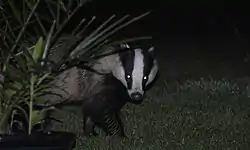Nocturnal bottleneck
The nocturnal bottleneck hypothesis is a hypothesis to explain several mammalian traits. In 1942, Gordon Lynn Walls described this concept which states that placental mammals were mainly or even exclusively nocturnal through most of their evolutionary story, starting with their origin 225 million years ago, and only ending with the demise of the non-avian dinosaurs 66 million years ago.[1] While some mammal groups have later evolved to fill diurnal niches, the approximately 160 million years spent as nocturnal animals has left a lasting legacy on basal anatomy and physiology, and most mammals are still nocturnal.[2]

Evolution of mammals

Mammals evolved from cynodonts, a group of superficially dog-like synapsids in the wake of the Permian–Triassic mass extinction. The emerging archosaurian groups that flourished after the extinction, including crocodiles and dinosaurs and their ancestors, drove the remaining larger cynodonts into extinction, leaving only the smaller forms.[3] The surviving cynodonts could only succeed in niches with minimal competition from the diurnal dinosaurs, evolving into the typical small-bodied insectivorous dwellers of the nocturnal undergrowth.[4] While the early mammals continued to develop into several probably quite common groups of animals during the Mesozoic, they all remained relatively small and nocturnal.
Only with the massive extinction at the end of the Cretaceous did the dinosaurs leave the stage open for the establishment of a new fauna of mammals. Despite this, mammals continued to be small-bodied for millions of years.[5] While all the largest animals alive today are mammals, the majority of mammals are still small nocturnal animals.[6]
Mammalian nocturnal adaptions
Several different features of mammalian physiology appear to be adaptations to a nocturnal lifestyle, mainly related to the sensory organs. These include:
Senses
- Acute sense of hearing, including external pinnae and auditory ossicles.
- Very good sense of smell, well developed nasal turbinates.
- Well developed sense of touch, and particularly the whiskers.[7]
- With the exception of higher primates, very large cornea, giving a less acute visual image compared to birds and reptiles.[8]
- Limited colour vision.[9]
Physiology
- Unique type of brown adipose tissue, allowing mammals to generate heat quickly.[10]
- Mitochondria with five to seven times higher respiration rates compared to reptiles of similar sizes.[11]
- Fur to assist in thermo-regulation in a cold (night) environment.
- Lack of shielding mechanism against (diurnal) ultraviolet light.[12] (This is not actually true, as fur is good for shielding from ultraviolet radiation.)
- The photolyase DNA mechanism, which relies on visible light, does not work in the placental mammals, despite being present and functional in bacteria, fungi, and most other animals.[13][14]
Behaviour
- Circadian rhythm and behaviour patterns in all basal groups are nocturnal, at least in placentals.[15][16]
- Burrowing lifestyle allowing sheltering from climate and diurnal predators appear to be a basal mammalian trait.[17]
References
- Gerkema MP, Davies WI, Foster RG, Menaker M, Hut RA. The nocturnal bottleneck and the evolution of activity patterns in mammals. Proc Biol Sci. 2013 Jul 3;280(1765):20130508. doi: 10.1098/rspb.2013.0508
- Sinn, J. "New Study Shows Effects of Prehistoric Nocturnal Life on Mammalian Vision". University of Texas. Retrieved 24 November 2014.
- Benton, Michael J. (2004). Vertebrate palaeontology (3rd ed.). Oxford: Blackwell Science. ISBN 978-0-632-05637-8.
- Kielan-Jaworowska, Zofia; Cifelli, Richard L.; Luo, Zhe-Xi (2004). Mammals from the age of dinosaurs : origins, evolution, and structure. New York: Columbia University Press. p. 5. ISBN 978-0-231-11918-4.
- Than, K. "Rise of Modern Mammals Occurred Long After Dinosaur Demise". LiveScience. Retrieved 24 November 2014.
- Gamberale-Stille, G.; Hall, K. S. S.; Tullberg, B. S. (10 August 2006). "Signals of profitability? Food colour preferences in migrating juvenile blackcaps differ for fruits and insects". Evolutionary Ecology. 20 (5): 479–490. doi:10.1007/s10682-006-0015-y. S2CID 45267536.
- Grant, Robyn; Mitchinson, Ben; Prescott, Tony (2011). "Vibrissal behaviour and function". Scholarpedia. 6 (10): 6642. Bibcode:2011SchpJ...6.6642P. doi:10.4249/scholarpedia.6642. Retrieved October 29, 2011.
- Hall, M. I.; Kamilar, J. M.; Kirk, E. C. (24 October 2012). "Eye shape and the nocturnal bottleneck of mammals". Proceedings of the Royal Society B: Biological Sciences. 279 (1749): 4962–4968. doi:10.1098/rspb.2012.2258. PMC 3497252. PMID 23097513.
- Davies, Wayne I. L.; Collin, Shaun P.; Hunt, David M. (July 2012). "Molecular ecology and adaptation of visual photopigments in craniates". Molecular Ecology. 21 (13): 3121–3158. doi:10.1111/j.1365-294X.2012.05617.x. PMID 22650357. S2CID 9077192.
- Cannon, B. (1 January 2004). "Brown Adipose Tissue: Function and Physiological Significance". Physiological Reviews. 84 (1): 277–359. doi:10.1152/physrev.00015.2003. PMID 14715917.
- Brand, M. D.; Couture, P.; Else, P. L.; Withers, K. W.; Hulbert, A. J. (1 April 1991). "Evolution of energy metabolism. Proton permeability of the inner membrane of liver mitochondria is greater in a mammal than in a reptile". The Biochemical Journal. 275 (1): 81–6. doi:10.1042/bj2750081. PMC 1150016. PMID 1850242.
- Ringvold, Amund (27 May 2009). "Aqueous humour and ultraviolet radiation". Acta Ophthalmologica. 58 (1): 69–82. doi:10.1111/j.1755-3768.1980.tb04567.x. PMID 6773294. S2CID 24655348.
- Lucas-Lledó JI, Lynch M (May 2009). "Evolution of mutation rates: phylogenomic analysis of the photolyase/cryptochrome family". Molecular Biology and Evolution. 26 (5): 1143–53. doi:10.1093/molbev/msp029. PMC 2668831. PMID 19228922.
- "Clues from a Somalian cavefish about modern mammals' dark past". Science Daily. Cell Press. October 11, 2018. Retrieved 11 October 2018.
- Gerkema, M. P.; Davies, W. I. L.; Foster, R. G.; Menaker, M.; Hut, R. A. (3 July 2013). "The nocturnal bottleneck and the evolution of activity patterns in mammals". Proceedings of the Royal Society B: Biological Sciences. 280 (1765): 20130508. doi:10.1098/rspb.2013.0508. PMC 3712437. PMID 23825205.
- Menaker, M.; Moreira, L.F.; Tosini, G. (March 1997). "Evolution of circadian organization in vertebrates". Brazilian Journal of Medical and Biological Research. 30 (3): 305–313. doi:10.1590/S0100-879X1997000300003. PMID 9246228.
- Damiani, R.; Modesto, S.; Yates, A.; Neveling, J. (22 August 2003). "Earliest evidence of cynodont burrowing". Proceedings of the Royal Society B: Biological Sciences. 270 (1525): 1747–51. doi:10.1098/rspb.2003.2427. PMC 1691433. PMID 12965004.
.jpg.webp)